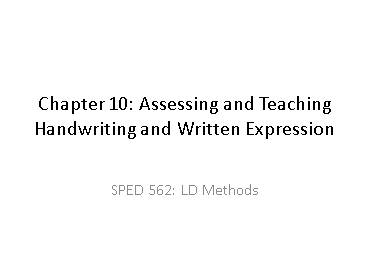Chapter 10: Assessing and Teaching Handwriting and Written Expression - PowerPoint PPT Presentation
1 / 9
Title:
Chapter 10: Assessing and Teaching Handwriting and Written Expression
Description:
Chapter 10: Assessing and Teaching Handwriting and Written Expression SPED 562: LD Methods Issues with writing Incorrect letter and number formation, also called ... – PowerPoint PPT presentation
Number of Views:184
Avg rating:3.0/5.0
Title: Chapter 10: Assessing and Teaching Handwriting and Written Expression
1
Chapter 10 Assessing and Teaching Handwriting
and Written Expression
- SPED 562 LD Methods
2
Issues with writing
- Incorrect letter and number formation, also
called dysgraphia - Difficulty or inability to write words fluently
from dictation - Difficulty with organization of words into
meaningful thoughts - Poorly formed or organized passages
3
Handwriting
- Teach positioning
- Back, head, wrist, elbow, and finger placement on
writing utensil - Tape paper to desk use clipboards to assist
position - Fade lines on paper to help develop size,
proportion and alignment - Start with capitals for ease of line development
- Line quality
4
Handwriting Skills
- Use close pins to work on a pincer grasp
- Exercise to work on wrist, elbow, shoulder, and
trunk strength - Copying geometric forms and lines
- Copying previously formed letters from one
specific point to the next - Faded instruction from copying to freehand
- Faded use of adaptive paper
5
Written Expression Issues
- Ones inability to communicate in writing or a
significantly lower level of written
communication - Characteristics of difficulty with WE
- poor or illegible handwriting
- poorly formed letters or numbers
- excessive spelling errors
- excessive punctuation errors
- excessive grammar errors
- sentences that lack logical cohesion
- paragraphs and stories that are missing elements
and that do not make sense or lack logical
transitions - deficient writing skills that significantly
impact academic achievement or daily life.
6
Teaching Writing
- Know the stages of writing and teach each one
explicitly and even directly one at a time. - Start with subject verb agreement
- Build in multiple nouns and verbs
- Teach conjunctions to combine sentences
- Vocabulary development improves sentence
readability - Teach outlining to combine ideas across sentences
- Teach organization using graphic organizers and
outlining techniques.
7
Supporting Writing (Block, 2003)
- Prewriting
- Make a list
- Create a semantic map (make a list of thoughts)
- Revise previous writings through reading work
aloud - Ramble and write for 10 minutes or focus writing
one idea for 10 minutes - Peer reading (also read to the peer)
- Create sentence starters
- First Draft
- Dictating
- Choose your own adventure books
- Dialog journals
- Storytelling first then write second
8
Supporting writing continued(Block, 2003)
- Revising Process
- Adding to the end keep going with afterthoughts
- Making insertions into a draft
- Highlight the main ideas
- Delete and rewrite ugh
- Self-Question
- Assessment Ideas
- Feedback should be plentiful, positive and
specific - Teach self-assessment about how the writer felt,
what he liked the best, the least, and why he
chose certain verbs or ideas
9
Questions
- Connect handwriting and written expression.
- How do we build handwriting ability?
- What is written expression and how do we assess
it? - Name techniques to support writing.

